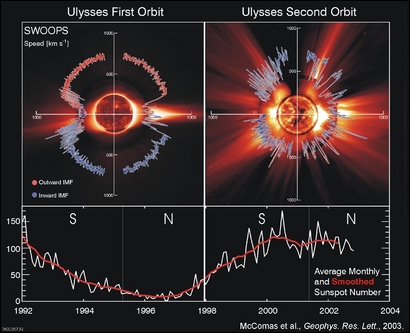Among the discoveries she made - the particles that are emitted from the sun and become the solar wind do not actually come from the poles * The interstellar dust that floods the solar system is 30 times more massive than previously thought and more. The reason for the termination, a decrease in electricity production capacity

For over 17 years, the Ulysses spacecraft shared by NASA and the European Space Agency studied the Sun, and was a pioneer in solar science and defining our knowledge of the heliosphere. However, on July 1, the mission will end. The spaceship was slowly dying Malfunctions in the electrical system. This system is no longer able to maintain the wall of the spacecraft during the phase away from the sun. Yet Ulysses survived nearly four times longer than its intended lifespan and forever changed the way scientists view the Sun and its effects on the space around it. Ulysses Gama covered a distance of 8.6 billion kilometers during her lifetime.
Ulysses ends her career after revealing that the magnetic field emitted from the Sun's poles is much weaker than previously observed. This means that the solar maximum - the sunspot peak - expected at the beginning of the next decade will be weaker than the previous peaks.
"During almost two decades of scientific observations by Ulysses we have learned much more than we expected about the Sun and the way it interacts with the space around it" says Richard Marsden, the chief scientist of the Ulysses project and the mission manager on behalf of the European Space Agency. "Many missions to the sun have been launched in recent years, but Ulysses is still unique even today. Its special point of view over the poles of the sun has never been covered by any other spacecraft."
Ulysses is on an orbit that brings it close to the Sun once every six years. Its long orbit brings it outside the orbit of Jupiter and back. The farther it gets from the sun, the cooler it gets. After the temperature inside it drops below two degrees Celsius, the hydrazine fuel used to navigate it freezes.
This was not a problem in the past because Ulysses carried heaters that maintained a reasonable working temperature inside. The spacecraft is powered by the decay of a radioactive isotope and for over 17 years, the power output has steadily decreased. Now the spacecraft is unable to generate enough power to operate all communications, heating and scientific equipment at the same time. The spacecraft and its ten scientific instruments must be highly sensitive, yet tough enough to withstand some of the harshest conditions in the solar system, including massive radiation as it passes over Jupiter's north pole.

Ulysses was the first spacecraft to survey the environment in space above וBelow To the poles of the sun in the four dimensions - the three dimensions of space and the dimension of time. It showed that the Sun's magnetic field is carried into the Solar System in a much more complicated way than previously estimated. The particles emitted from the sun at low latitudes can climb to high latitudes and vice versa, sometimes they find themselves on an unexpected path out to the planets. Ulysses also studied the flow of dust from outer space into the solar system and showed that it is 30 times richer than scientists had estimated. In addition, the spacecraft discovered helium atoms from outer space and proved that the universe does not contain enough material to eventually stop its expansion.
"Ulysses has been a challenging mission since launch," says Ed Massey, Ulysses project manager at NASA's Jet Propulsion Laboratory (JPL). Its success required the cooperation and intellect of engineers and scientists from all over the world."
"When the last bits of data arrive they will surely be strong enough to say hello," said Nigel Angold, Ulysses operations manager for the European Space Agency. But any sadness I may feel will pale in comparison to the pride of working on such an amazing task. Although the operation of the spacecraft will cease, the scientific discoveries still hidden within the data transmitted by Ulysses during its many years of operation will continue to provide work for scientists for many years."

3 תגובות
Avner:
They once tried to calculate the amount of material to see if there would eventually be a collapse.
The assumption was that in any case there is a slowdown in the expansion of the universe and the question was whether it is a slowdown that will last forever while the universe continues to expand (slower but still expanding) or whether the slowdown will reach such dimensions that the expansion will stop and collapse will begin.
Since then it has become clear that the expansion of the universe in general is accelerating and not slowing down.
This fact means that there is no deceleration at all and therefore the whole idea of calculating the amount of mass to see if there will be a collapse in the end has lost its validity.
Today, the acceleration is attributed to dark energy, the nature of which is unknown.
If it continues to operate the way it is operating, it is hard to see a collapse on the horizon (although all kinds of ideas about circular dimensions could lead to this, but this is currently a speculation that has nothing to rely on)
Does the "proof" that "the universe does not contain enough matter to eventually stop its expansion" also take into account the dark mass, which has not yet been detected but may be detected and monitored in the future or does it refer only to visible matter? Or maybe it is the very discovery of the inflationary universe that leads to the conclusion that
The mass of the universe is too small to cause it to collapse. Although to the best of my knowledge the discovery of the inflationary universe was made by Hubble.